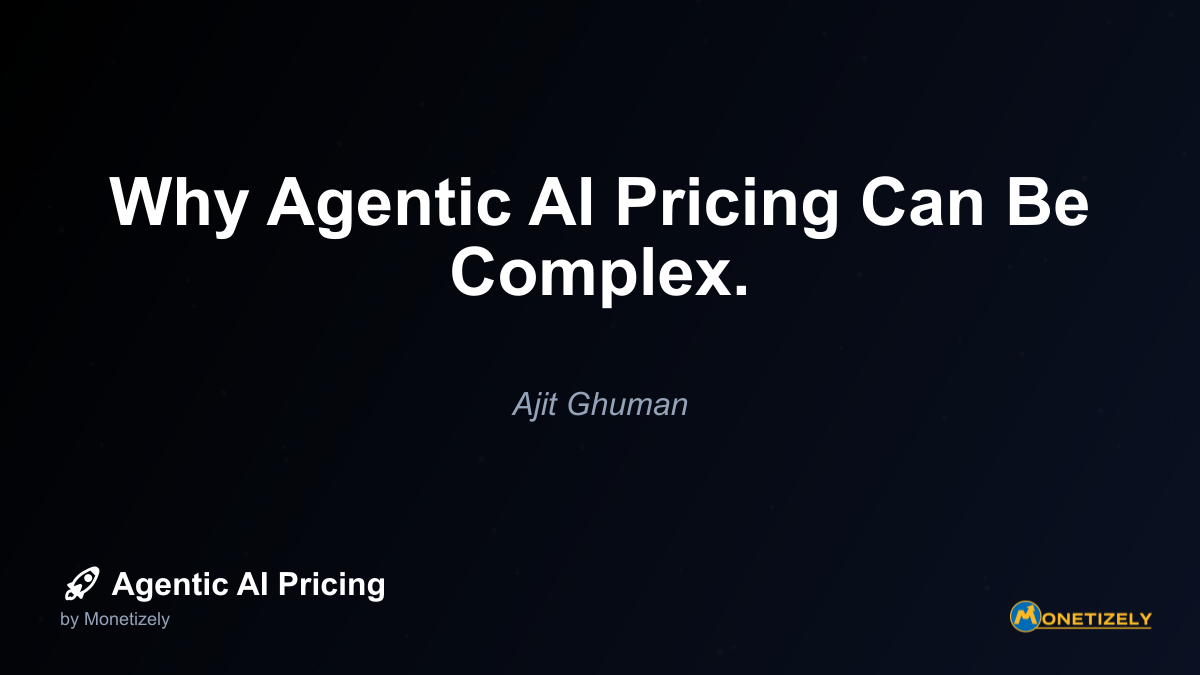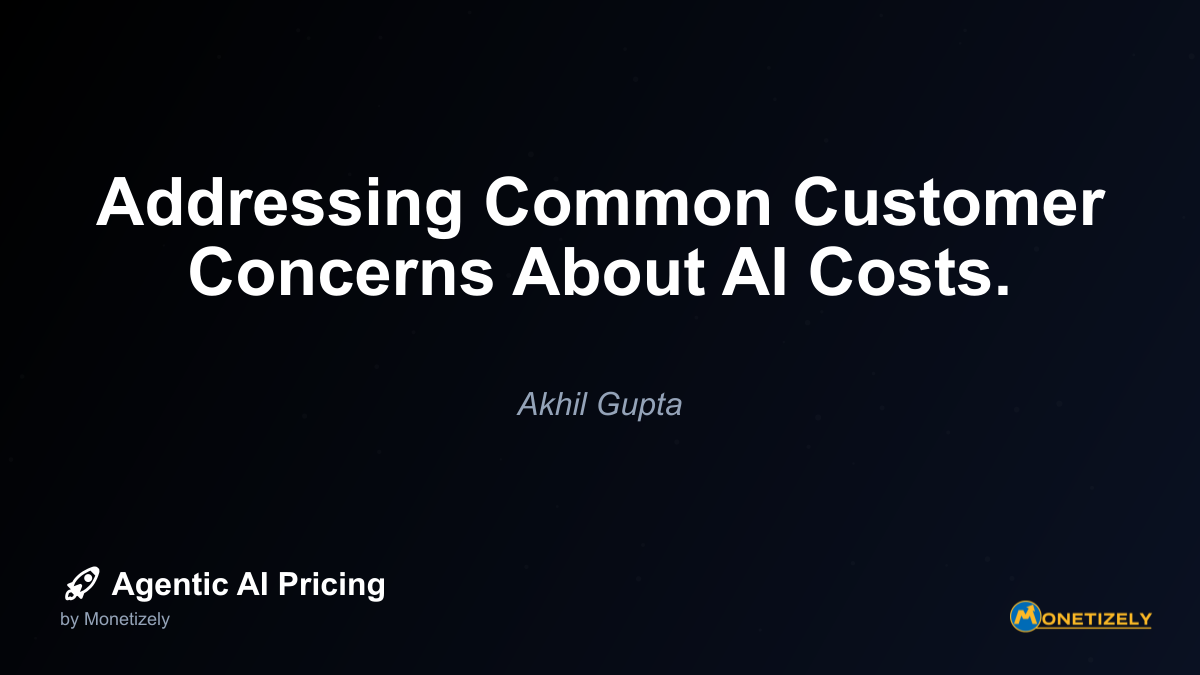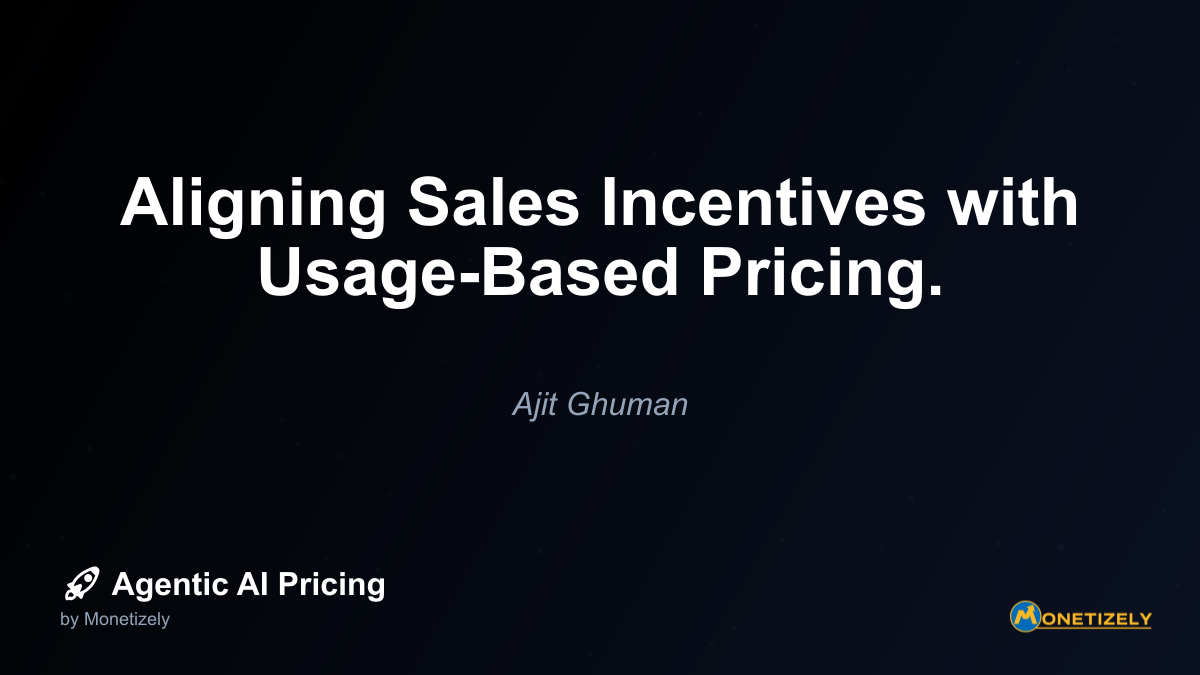· Ajit Ghuman · Best Practices · 11 min read
Why Agentic AI Pricing Can Be Complex.
AI and SaaS Pricing Masterclass
Learn the art of strategic pricing directly from industry experts. Our comprehensive course provides frameworks and methodologies for optimizing your pricing strategy in the evolving AI landscape. Earn a professional certification that can be imported directly to your LinkedIn profile.

The complexity of pricing agentic AI services stems from a multifaceted web of technological, economic, and strategic factors that traditional pricing models struggle to address. Unlike conventional software with predictable usage patterns and fixed costs, agentic AI introduces unique challenges that demand sophisticated pricing approaches.
Unpredictable Usage Patterns: The Variability Challenge
Agentic AI services exhibit highly variable and non-linear usage patterns that complicate revenue forecasting and margin control. This unpredictability stems from several factors:
User Behavior Variability: Different users interact with AI agents in dramatically different ways. Some may engage in brief, straightforward interactions while others conduct complex, multi-step dialogues that consume significantly more resources.
Input Complexity Differences: The complexity of user inputs varies widely, with some queries requiring minimal processing while others demand extensive computation, reasoning, and context management.
Interaction Length Fluctuations: The duration and depth of user engagement sessions can range from seconds to hours, making resource allocation and cost prediction challenging.
This unpredictability creates a fundamental pricing dilemma: flat-rate models risk significant losses when users consume more resources than anticipated, while purely usage-based models can lead to customer bill shock and hesitancy to fully utilize the service.
Variable Compute Costs: The Resource Equation
The computational requirements of agentic AI services represent another major complexity factor:
Model Size Impact: Larger, more capable AI models require substantially more computational resources to run, with costs scaling non-linearly with model size.
Input/Output Complexity: Processing complex queries or generating detailed outputs demands more computational work than simpler interactions.
Inference Workload Scale: The volume of inference requests can fluctuate dramatically based on customer usage patterns, time of day, or seasonal factors.
According to IBM research, computing costs related to AI are expected to rise by 89% from 2023 to 2025, driven heavily by generative AI adoption. This cost volatility makes static pricing models increasingly risky and reduces the predictability of profitability margins.
The technical challenges extend beyond basic compute costs. As one industry expert notes, “Running agentic AI involves infrastructure beyond just the models—such as coordination among multiple agents, retrieval systems, embedding models, and latency management—which adds layers of costs that multiply with agent complexity, especially in multi-agent setups.”
Multiple Value Streams: The Business Impact Maze
Agentic AI delivers value across numerous dimensions of an organization, making it difficult to isolate and price based on a single value metric:
Cross-Functional Impact: AI agents can simultaneously improve customer experience, streamline operations, enhance product development, and drive revenue growth.
Indirect Value Creation: Many benefits materialize indirectly or through complex causal chains, such as improved decision quality leading to better strategic outcomes over time.
Varied Stakeholder Perspectives: Different stakeholders within customer organizations may value different aspects of the same AI service, complicating value perception and willingness to pay.
This multidimensional value creation challenges traditional pricing models that rely on clear, singular value metrics. As BCG researchers note, “Agentic AI can impact many facets of a company’s operations and offerings. Pricing must reflect these diverse and sometimes intangible value contributions, complicating straightforward price setting.”
Measuring Outcomes: The Attribution Problem
Perhaps the most fundamental complexity in agentic AI pricing is the difficulty in measuring and attributing business outcomes directly to AI interventions:
Complex Causal Chains: The relationship between AI actions and business results often involves multiple steps and influencing factors, making direct attribution challenging.
Delayed Effects: Many AI-driven benefits materialize over extended timeframes rather than immediately, complicating ROI calculations.
Counterfactual Uncertainty: Determining what would have happened without the AI intervention—the true measure of impact—is inherently speculative.
Industry analysts highlight this challenge: “Quantifying the direct business impact or ROI of AI services is challenging due to complex causal chains and delayed effects, making it difficult to align pricing with true value delivered.”
The Measurement Imbalance
Research reveals a significant measurement imbalance in evaluating agentic AI, with 83% of industry evaluations using technical benchmarks but only 30% incorporating human-centered metrics, 53% assessing safety dimensions, and just 30% measuring economic impact. This imbalance creates a disconnect between benchmark success and real deployment value.
As one researcher explains, “This measurement imbalance undermines productivity claims as critical contextual factors remain unmeasured.” Companies struggle to develop pricing models that accurately reflect the full spectrum of value when critical dimensions remain unquantified.
Technical Cost Drivers and Infrastructure Requirements
Beyond the high-level challenges, specific technical factors drive cost variability in agentic AI:
Non-Linear Data Processing Costs: Processing more complex or larger data sets can cause costs to scale non-linearly rather than proportionally, complicating forecasting and pricing.
Orchestration Overhead: The coordination of multiple AI components, especially in multi-agent setups, adds significant infrastructure costs that scale with system complexity.
Integration Complexity: Connecting AI agents to existing enterprise systems introduces additional costs that vary widely based on the customer’s technical environment.
These technical factors create a complex cost structure that doesn’t align well with traditional software pricing approaches, which typically assume more predictable infrastructure requirements.
Industry-Specific Pricing Challenges
Different industries impose unique constraints on AI agent pricing due to regulatory environments, cost structures, and use case complexity:
Healthcare and Finance: Must factor in compliance with strict data privacy, audit requirements, and risk mitigation costs, raising development and operational prices.
Retail and Customer Support: Often demand scalable, flexible pricing tied to transaction volume or interactions, balancing predictability and variable usage.
Enterprise vs. Startup: Enterprises require highly secure, deeply integrated AI agents with regulatory compliance, leading to higher pricing reflecting complexity and risk controls.
Evolving Pricing Models: Addressing the Complexity
In response to these complexities, several pricing approaches have emerged:
Value-Based Pricing
This approach ties pricing directly to the quantifiable economic value the AI agent delivers. For example, if an AI agent saves a company $100,000 annually in labor costs, pricing might be set between $30,000-$50,000 per year to share the created value fairly.
Value-based pricing works particularly well for enterprise use cases where ROI is measurable and significant. It aligns vendor incentives with customer success but requires sophisticated value measurement capabilities.
Usage-Based Pricing
Usage-based models charge based on consumption metrics like API calls, tokens processed, or compute time. While flexible and transparent, these models can lead to unpredictable bills for customers and may not reflect the true business value delivered.
As one pricing expert notes, “Usage-based pricing offers flexibility but low predictability and risks commoditization.” This approach is often most suitable during pilot phases or for applications with highly variable usage patterns.
Outcome-Based Pricing
This model links payment directly to business results achieved, such as costs saved, revenue increased, or specific performance improvements. It creates strong alignment between vendor and customer interests but requires high confidence in AI performance and clear outcome attribution.
Hybrid Pricing Models
Increasingly, companies are adopting hybrid approaches that combine multiple pricing components:
Base Subscription + Usage: A fixed subscription fee provides access to core capabilities, with additional charges based on usage volume or intensity.
Tiered Capabilities + Outcome Sharing: Different capability tiers with varying price points, plus outcome-based components that share in the value created.
Credit-Based Systems: Prepaid credits that can be applied to various AI services based on customer needs and priorities.
As one industry report states, “Hybrid pricing models combining subscription guarantees and usage-based adjustments are emerging as a sustainable approach.”
Case Studies: Innovative Pricing in Practice
Several companies have pioneered innovative pricing approaches for agentic AI services:
Monetizely developed a value-based pricing model specifically tailored for agentic AI SaaS products. Their approach aligns pricing with autonomous outcomes delivered by the software, avoiding typical pitfalls like flat subscriptions or simple usage-based fees which poorly reflect the product’s dynamic value and cost structure.
Major Cloud Platforms including AWS, Databricks, Google Cloud, and Salesforce have launched agentic AI tools that blend SaaS predictability with usage and pay-for-results models, reflecting the transformative impact on operational efficiency and customer engagement.
Airline Dynamic Pricing Agents employ agentic AI to optimize over 200 pricing variables in real time, resulting in 8-12% revenue increases. This real-time, multi-factor optimization supports dynamic pricing models that more closely link prices to actual market demand and supply conditions.
The Transparency Imperative
Regardless of the pricing model chosen, transparency emerges as a critical factor in addressing agentic AI pricing complexity:
Usage Visibility: Providing granular usage breakdowns, clear cost triggers, and predictable billing cycles helps avoid surprise expenses and builds trust.
Cost Component Clarity: Transparently itemizing technical costs (compute resources, model inference, storage) helps customers understand cost drivers.
ROI Measurement Tools: Offering tools and frameworks to help customers measure the business impact of AI investments supports value-based pricing conversations.
As one industry expert advises, “Use real-time usage dashboards and predictive billing tools to forecast spending and optimize costs proactively.”
Regulatory and Ethical Considerations
Pricing agentic AI services must also navigate evolving regulatory and ethical landscapes:
Transparency Requirements: Agentic AI services typically require clear and explainable pricing models to align with their autonomous and outcome-based value creation.
Fairness Considerations: Hybrid pricing approaches combining base subscription fees with usage-based or outcome-based components help ensure customers pay in proportion to value received and usage intensity.
Future Regulatory Landscape: Given the autonomous nature of agentic AI, future regulations may mandate disclosures about how AI decisions affect pricing, require non-discriminatory pricing strategies, and enforce consumer protection related to AI-driven outcomes.
A Strategic Framework for Pricing Agentic AI
Based on industry best practices, a three-phase pricing evolution framework can help companies develop comprehensive pricing strategies:
Phase 1: Establishing Value (0-6 months)
- Implement simple consumption-based pricing with usage caps
- Focus on proving value with minimum customer commitment
- Gather detailed usage data to inform future pricing refinements
Phase 2: Optimizing Predictability (6-18 months)
- Transition to hybrid models balancing subscription, usage, and early outcome pricing
- Establish baseline usage patterns and improve cost predictability
- Develop value measurement capabilities and ROI tracking
Phase 3: Maximizing Value Alignment (18+ months)
- Implement sophisticated outcome/value-based pricing and gain-sharing partnerships
- Optimize enterprise-wide pricing strategies
- Reward value creation through aligned incentives
This phased approach allows companies to evolve their pricing strategies alongside their understanding of customer usage patterns, value realization, and cost structures.
Future Trends in Agentic AI Pricing
Looking ahead, several trends are likely to shape the future of agentic AI pricing:
Agent-Based Pricing Models: Charging customers per AI agent, reflecting the autonomous “digital labor” that AI agents perform. This approach might mirror human labor costs (e.g., OpenAI’s rumored $20,000/month PhD-level research agent).
Increased Value Alignment: Pricing will increasingly reflect real-world business outcomes and efficiencies gained by agentic AI rather than simple usage or seat counts alone.
Flexible Switching Options: Customers will expect the ability to switch between usage-based or subscription-like pricing based on scale and application context.
As one industry forecast suggests, “Agentic AI pricing is moving toward hybrid, flexible, and value-based models that reflect autonomous agent impact and business outcomes, supported by clear, predictable costs.”
Recommendations for Businesses
For companies developing or evaluating agentic AI pricing strategies, several key recommendations emerge:
Align Pricing with Value Delivery: Choose pricing metrics that reflect the true economic value created by your AI agents, not just the resources consumed.
Structure Clear Pricing Tiers: Create tiered subscription packages that segment customers by capability needs and willingness to pay, with a clear progression path as they realize more value.
Manage Complexity Proactively: Provide pricing transparency with clear breakdowns of costs, usage dashboards, and predictive billing to avoid surprises.
Evolve Your Approach Systematically: Start with simpler pricing models during pilot phases, then gradually incorporate more sophisticated elements as your understanding of customer value and usage patterns matures.
Collaborate Cross-Functionally: Work across product, engineering, marketing, and sales teams to implement effective measurement and tracking of pricing metrics.
Conclusion: Embracing the Complexity
The complexity of pricing agentic AI services reflects the revolutionary nature of this technology. Unlike traditional software, agentic AI operates with greater autonomy, delivers value across multiple dimensions, and consumes resources in ways that vary dramatically based on usage patterns and implementation contexts.
Successfully navigating this complexity requires a strategic approach that balances technical realities with business value creation. Companies must move beyond simplistic pricing models to develop sophisticated, multi-faceted approaches that align incentives, manage unpredictability, and clearly communicate value.
As agentic AI continues to evolve and mature, so too will pricing strategies. The most successful companies will be those that view pricing not as a static decision but as an ongoing process of refinement and alignment—one that evolves alongside the technology itself and the value it creates for customers.
By embracing rather than avoiding this complexity, businesses can develop pricing models that accurately reflect the transformative potential of agentic AI while building sustainable, profitable relationships with their customers. In doing so, they’ll not only capture fair value for their innovations but also accelerate the adoption of technologies that promise to reshape how we work, create, and solve problems in the years ahead.
Co-Founder & CEO
Ajit is the author of Price To Scale, a top book on SaaS Pricing and is the Founder of Monetizely. Ajit has led and worked in pricing and product marketing at firms like Twilio, Narvar and Medallia. His work has been featured in Forbes and VentureBeat. Ajit regularly consults with software companies from Seed stage to post-IPO on pricing strategy. Ajit is also a highly-rated co-instructor for 'The Art of SaaS Pricing and Monetization' on Maven.
Pricing Strategy Audit
Let our experts analyze your current pricing strategy and identify opportunities for improvement. Our data-driven assessment will help you unlock untapped revenue potential and optimize your AI pricing approach.




